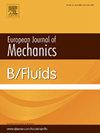Numerical study of converging shock wave interaction with offset gas bubble containing different gases - Ne, Ar or CO2
IF 2.5
3区 工程技术
Q2 MECHANICS
引用次数: 0
Abstract
This study presents a numerical investigation of the interaction between a converging shock wave and an offset cylindrical gas bubble containing Ne, Ar, or CO2. Based on the good agreement with experimental findings shown in our previous study, we explored how these gases influence shock wave patterns when a converging shock wave propagating at a Mach number of 1.18 impacts a 50 mm diameter cylindrical bubble. The results reveal complex shock wave dynamics that differ from those observed when planar shocks impact on a cylindrical gas bubble or when a converging shock wave impacts a cylindrical gas bubble located at the center of its focus. Notably, in the case of a Ne-filled bubble, the shock wave focus is outside of the initial bubble location. Each gas produced distinct shock wave behaviors: the Ne bubble exhibited lens-like shock patterns, while in the Ar bubble's case the transmitted and converging shock waves were circular. A second shock wave focusing of the transmitted shock wave was observed inside the Ar bubble, similar to the case of the CO2 bubble, which experienced earlier focusing than in the SF6 case (previously studied) but later than Ar. The position of the transmitted shock wave's focus within the bubble varies with gas density, showing that heavier gases result in a focal point located further inside the bubble.
收敛激波与含不同气体(Ne、Ar或CO2)的偏置气泡相互作用的数值研究
本研究提出了收敛激波与含有Ne, Ar或CO2的偏移圆柱气泡之间相互作用的数值研究。基于与我们先前研究的实验结果的良好一致性,我们探索了当以1.18马赫数传播的会聚激波撞击直径为50 mm的圆柱形气泡时,这些气体如何影响激波模式。结果表明,复杂的激波动力学不同于平面激波冲击圆柱形气泡或会聚激波冲击位于其焦点中心的圆柱形气泡时所观察到的激波动力学。值得注意的是,在充满ne的气泡中,激波焦点在初始气泡位置之外。每种气体都产生了不同的激波行为:Ne气泡表现出透镜状的激波模式,而Ar气泡的情况下,传输和汇聚的激波是圆形的。在Ar泡内观察到透射激波的第二次激波聚焦,与CO2泡的情况类似,其聚焦比SF6的情况(先前的研究)早,但比Ar的情况晚。透射激波的焦点在泡内的位置随气体密度的变化而变化,表明较重的气体导致焦点位于泡内更远的地方。
本文章由计算机程序翻译,如有差异,请以英文原文为准。
求助全文
约1分钟内获得全文
求助全文
来源期刊
CiteScore
5.90
自引率
3.80%
发文量
127
审稿时长
58 days
期刊介绍:
The European Journal of Mechanics - B/Fluids publishes papers in all fields of fluid mechanics. Although investigations in well-established areas are within the scope of the journal, recent developments and innovative ideas are particularly welcome. Theoretical, computational and experimental papers are equally welcome. Mathematical methods, be they deterministic or stochastic, analytical or numerical, will be accepted provided they serve to clarify some identifiable problems in fluid mechanics, and provided the significance of results is explained. Similarly, experimental papers must add physical insight in to the understanding of fluid mechanics.

 求助内容:
求助内容: 应助结果提醒方式:
应助结果提醒方式:


